
Earl William "Madman" Muntz was an American businessman and engineer who sold and promoted cars and consumer electronics in the United States from the 1930s until his death in 1987. He was a pioneer in television commercials with his oddball "Madman" persona; an alter ego who generated publicity with his unusual costumes, stunts, and outrageous claims. Muntz also pioneered car stereos by creating the Muntz Stereo-Pak, better known as the 4-track cartridge, a predecessor to the 8-track cartridge developed by Lear Industries.

Pimp My Ride is an American television series produced by MTV and hosted by rapper Xzibit, which ran for six seasons on MTV from 2004 to 2007. In each episode, a car in poor condition is both restored and customized. The work on the show was done by West Coast Customs until season 5 and was done by Galpin Auto Sports thereafter.

George Barris was an American designer and builder of Hollywood custom cars. Barris designed and built the Hirohata Merc. Barris's company, Barris Kustom Industries, designed and built the Munster Koach and DRAG-U-LA for The Munsters; and the 1966 Batmobile for the Batman TV series and film.
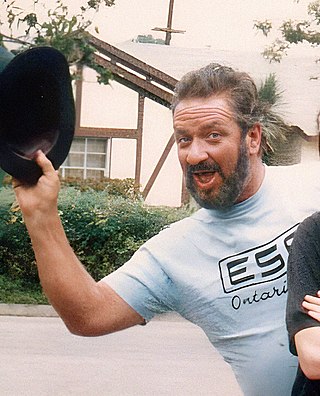
Ed "Big Daddy" Roth was an American artist, cartoonist, illustrator, pinstriper and custom car designer and builder who created the hot rod icon Rat Fink and other characters. Roth was a key figure in Southern California's Kustom Kulture and hot rod movement of the late 1950s and 1960s.

West Coast Customs is an automobile repair shop focusing on the customization of vehicles. It was started by co-founders Ryan Friedlinghaus and Quinton Dodson circa 1994. According to Friedlinghaus, he began the business with a $5,000 loan from his grandfather, but other sources claim that he raised the seed money for the business while working at his father's liquor store. Owing to the patronage of celebrities such as Shaquille O'Neal and Sean Combs, along with appearances in the reality television programs Pimp My Ride and Street Customs, the company has gained a high degree of notoriety and has become a multimillion-dollar business.
Maaco Collision Repair & Auto Painting is an American franchisor of auto painting and collision repair shops based in Charlotte, North Carolina. It was founded in 1972 by Anthony A. Martino and Daniel I. Rhode.

AAMCO is an American transmission-repair franchise founded by Robert Morgan and Anthony A. Martino in 1957 in Philadelphia. Martino eventually ended his affiliation with AAMCO to manage the MAACO autobody-shop franchise, but Morgan stayed on with his son, Keith Morgan, succeeding him as CEO.
Mark Machado, better known as Mr. Cartoon or more commonly just Cartoon or Toon, is an American tattoo artist and graffiti artist based in Los Angeles, California. Growing up in the Harbor area of Los Angeles County, young Cartoon began doing illustrations and graffiti then going on to airbrushing clothing and lowrider custom cars. Machado then moved on to working in the music industry doing album covers, tour merchandise, and later tattooing recording artists and other celebrities.
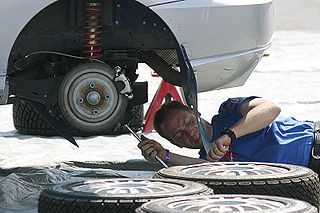
An auto mechanic is a mechanic who services and repairs automobiles, sometimes specializing in one or more automobile brands or sometimes working with any brand. In fixing cars, their main role is to diagnose and repair the problem accurately and quickly. Seasoned auto repair shops start with a (Digital) Inspection to determine the vehicle conditions, independent of the customers concern. Based on the concern, the inspection results and preventative maintenance needs, the mechanic/technician returns the findings to the service advisor who then gets approval for any or all of the proposed work. The approved work will be assigned to the mechanic on a work order. Their work may involve the repair of a specific part or the replacement of one or more parts as assemblies. Basic vehicle maintenance is a fundamental part of a mechanic's work in modern industrialized countries, while in others they are only consulted when a vehicle is already showing signs of malfunction.
Calvin Coolidge Worthington was an American car dealer, best known in Southern California and other locations along the West Coast of the United States for his offbeat radio and television advertisements for his Worthington Dealership Group, a car dealership chain that covered the western and southwestern U.S. at its peak, and later for his minor appearances and parodies in a number of movies.
Leif Christopher Hansen is the founder and owner of a chain of auto body shops, Leif's Auto Collision Centers.
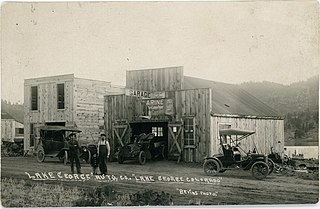
An automobile repair shop is an establishment where automobiles are repaired by auto mechanics and technicians. The customer interface is typically a service advisor, traditionally called a service writer.

Ziebart International Corporation is a privately owned corporation based in Troy, Michigan, and is the worldwide franchisor of the Ziebart brand of automotive aftermarket stores.

Farmers Insurance Group is an American insurer group of vehicles, homes and small businesses and also provides other insurance and financial services products. Farmers Insurance has more than 48,000 exclusive and independent agents and approximately 21,000 employees. Farmers is the trade name for three reciprocal exchanges, Farmers, Fire, and Truck, each a managed by Farmers Group, Inc. as attorney-in-fact on behalf of their respective policyholders. Farmers Group, Inc. is a wholly owned subsidiary of Swiss-based Zurich Insurance Group.
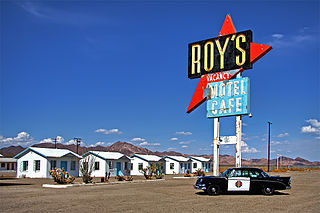
Roy's Motel and Café is a motel, café, gas station and auto repair shop on the National Trails Highway, the former U.S. Route 66, in the Mojave Desert town of Amboy in San Bernardino County, California. It has been defunct for years, but is now being restored. The historic site is an example of roadside Mid-Century Modern Googie architecture. The entire town of Amboy—including the Roy's complex—is owned by and under the stewardship of a private preservationist.
Paintless dent repair (PDR), also known as paintless dent removal, describes a method of removing small dents, dings, and minor collision damage dents from the body of a motor vehicle. A wide range of damage can be repaired using paintless dent repair as long as the paint surface is intact. Paintless dent repair may be used on both aluminum and steel panels.

The Los Angeles Pacific Railroad (1896−1911) (LAP) was an electric public transit and freight railway system in Los Angeles County, California. At its peak it had 230 miles (370 km) of track extending from Downtown Los Angeles to the Westside, Santa Monica, and the South Bay towns along Santa Monica Bay.
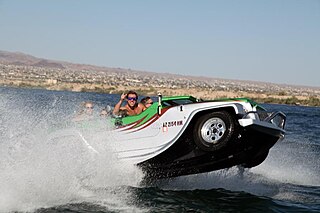
WaterCar is an American company that specializes in the manufacture and development of luxury amphibious vehicles. Based in Southern California, the company was founded by Dave March in 1999 when he was inspired by the Amphicar of the 1960s. March claims he originally had no plans to market an amphibious vehicle — just merely to build one. In 2013, the company released its first commercial vehicle, the Panther, which holds a top speed of 80 mph (130 km/h) on land and 45 mph (72 km/h) on water. The company holds 27 amphibious related patents as well as the Guinness World Record for the fastest amphibious vehicle. WaterCar vehicles are designed and manufactured at Fountain Valley BodyWorks, an 85,000 square feet (7,900 m2) collision repair auto body shop in Southern California, owned and operated by March.
Homer B. Roberts (1885–1952) was a graduate of Kansas State Agricultural College and veteran of World War I who was the first black man to attain the rank of lieutenant in the United States Army Signal Corps. He began his auto business by placing ads in the local paper advertising used cars. By the end of 1919, Roberts had negotiated over 60 car sales exclusively for African-American buyers. He hired two salesmen to work his lot, offered auto insurance and payment terms to customers, and later founded Roberts Motors, the first African-American owned car dealership in the United States.
Fran's Valentine was a Thoroughbred racehorse filly, who, in 1985 as a three-year-old, won the Graded stakes races the Hollywood Oaks, Kentucky Oaks and Santa Susana Stakes. Trained by Joseph Manzi, she was the first filly to win both the Kentucky Oaks and Hollywood Oaks. Her lifetime earnings were $1,375,465, and she had 13 wins from 34 races.














